Skanska Bundle
Can Skanska Maintain Its Momentum?
From its roots in 1887 Sweden, Skanska has become a global construction and development leader, but what's next? This Skanska SWOT Analysis unveils the company's strategic vision, from sustainable urban projects to ambitious expansion plans. Discover how Skanska is navigating the complexities of the construction industry and building a future that prioritizes innovation and sustainability.
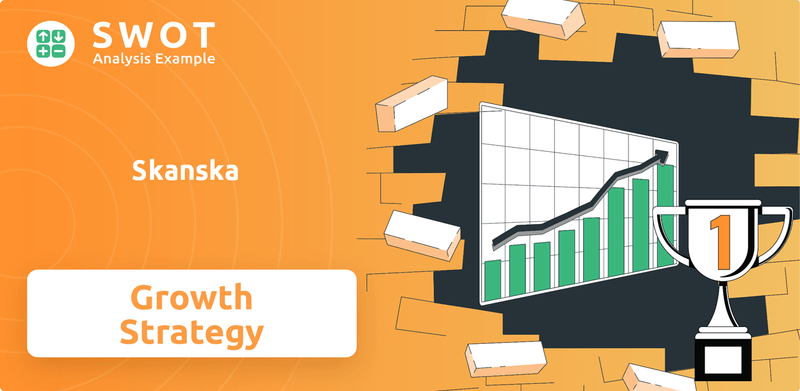
This deep dive into Skanska's Skanska growth strategy will explore its Skanska future prospects, examining key factors like Skanska financial performance and Skanska market position. We'll analyze its response to construction industry trends, including its investment in digital construction and its approach to Skanska's sustainable construction initiatives. Furthermore, we'll investigate Skanska's expansion plans in North America and its strategies for risk management, providing a comprehensive Skanska company analysis for informed decision-making.
How Is Skanska Expanding Its Reach?
Skanska's expansion initiatives are carefully designed to leverage its core strengths while seeking new avenues for growth. This strategy focuses on both expanding its geographical reach and diversifying its project portfolio. A key aspect involves strategic investments in new markets and strengthening its presence in existing ones, particularly in the US and Nordic countries. This approach is crucial for maintaining and enhancing its market position within the competitive construction industry.
The company's growth strategy involves a multifaceted approach that includes significant investments in infrastructure projects. For example, Skanska is involved in projects like the construction of the new I-270 bridge over the Mississippi River in St. Louis, Missouri, showcasing its capacity for large-scale public-private partnerships. This highlights Skanska's ability to undertake complex and large-scale projects, which is a key driver for revenue growth. Moreover, Skanska is committed to sustainable practices, aiming for net-zero carbon emissions by 2045, with a 70% reduction by 2030, driving innovation in construction methods and material choices.
Skanska's commitment to sustainability is a major factor in its expansion plans. This includes developing energy-efficient commercial and residential buildings, aligning with the rising demand for green building solutions. Skanska's future prospects also involve exploring new business models, such as integrated project delivery and early contractor involvement, to enhance collaboration and efficiency. Partnerships with technology providers are also essential for accessing new capabilities and market segments, particularly in smart infrastructure and digital construction. For more insights, consider reading about the Brief History of Skanska.
Skanska is actively expanding its presence in key markets like the US and the Nordic countries. This includes pursuing large infrastructure projects and strengthening its position in existing markets. The focus is on both organic growth and strategic acquisitions to enhance its market share.
The company is heavily investing in sustainable and green building solutions. This involves developing energy-efficient commercial and residential properties to meet the growing demand for environmentally friendly construction. Skanska aims to achieve net-zero carbon emissions by 2045.
Skanska is embracing digital construction and smart infrastructure technologies. This includes partnerships with tech providers to enhance project efficiency and explore new market segments. The integration of technology is a key element of its long-term strategy.
The company is exploring innovative business models such as integrated project delivery. This approach aims to improve collaboration and efficiency in complex projects. These models are designed to streamline operations and enhance project outcomes.
Skanska's expansion strategy includes geographical diversification and a focus on sustainable construction. This involves strategic investments in key markets and the adoption of new technologies. The company is also committed to reducing its carbon footprint.
- Strategic investments in the US and Nordic countries.
- Focus on sustainable and green building solutions.
- Integration of digital construction and smart infrastructure.
- Adoption of innovative business models for project delivery.
Skanska SWOT Analysis
- Complete SWOT Breakdown
- Fully Customizable
- Editable in Excel & Word
- Professional Formatting
- Investor-Ready Format
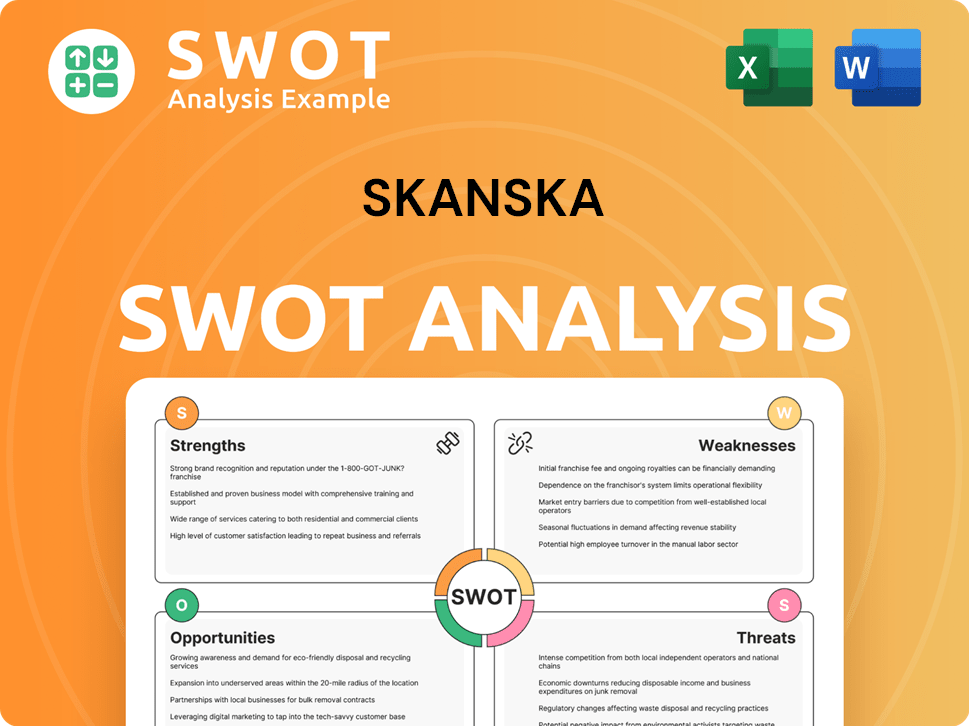
How Does Skanska Invest in Innovation?
The innovation and technology strategy of Skanska is crucial for its ongoing growth, focusing on boosting efficiency, safety, and sustainability across its operations. The company actively invests in research and development, frequently working with external innovators, universities, and tech startups to explore advanced solutions. This approach is essential to understanding the Target Market of Skanska.
A key part of their strategy is digital transformation, which includes the widespread use of Building Information Modeling (BIM) for better project planning and execution, as well as digital tools for site management and progress tracking. Skanska is also using automation in various construction processes to improve productivity and reduce manual labor, such as robotic welding and automated material handling.
Skanska is actively exploring and implementing advanced technologies like Artificial Intelligence (AI) and the Internet of Things (IoT) to optimize resource allocation, predict potential issues, and improve decision-making. For example, AI-powered analytics can be used to analyze large amounts of project data to identify patterns and improve future project outcomes. IoT sensors are deployed on construction sites to monitor equipment performance, material usage, and environmental conditions, contributing to greater efficiency and safety.
Skanska's digital transformation efforts include the adoption of Building Information Modeling (BIM) for enhanced project planning and execution. Digital tools are also used for site management and progress tracking, improving overall project efficiency.
Automation is used in various construction processes to boost productivity and reduce manual labor. Examples include robotic welding and automated material handling, leading to increased efficiency and reduced costs.
The company is integrating Artificial Intelligence (AI) and the Internet of Things (IoT) to optimize resource allocation and enhance decision-making. AI-powered analytics help analyze project data, while IoT sensors monitor equipment and environmental conditions.
Skanska's innovation strategy deeply integrates sustainability, focusing on low-carbon materials and energy-efficient building systems. This includes utilizing fossil-free asphalt and electrifying construction sites.
Skanska actively collaborates with external innovators, universities, and technology startups to explore cutting-edge solutions. This collaborative approach fosters innovation and drives technological advancements.
Significant investment in research and development is a core element of Skanska's strategy. This investment supports the exploration and implementation of new technologies and sustainable practices.
Skanska's commitment to sustainability is deeply integrated into its innovation strategy, with a focus on developing and utilizing low-carbon materials, energy-efficient building systems, and circular economy principles in their projects. This includes initiatives like utilizing fossil-free asphalt and electrifying construction sites. Their leadership in sustainable construction is recognized through various industry awards and certifications, demonstrating their commitment to pioneering environmentally responsible building practices.
- Low-Carbon Materials: Using materials with reduced carbon footprints to minimize environmental impact.
- Energy-Efficient Systems: Implementing building designs and systems that conserve energy and reduce operational costs.
- Circular Economy: Adopting practices that minimize waste and maximize the reuse of materials.
- Fossil-Free Asphalt: Utilizing asphalt alternatives to reduce reliance on fossil fuels.
- Electrification of Sites: Transitioning construction sites to electric-powered equipment to reduce emissions.
Skanska PESTLE Analysis
- Covers All 6 PESTLE Categories
- No Research Needed – Save Hours of Work
- Built by Experts, Trusted by Consultants
- Instant Download, Ready to Use
- 100% Editable, Fully Customizable
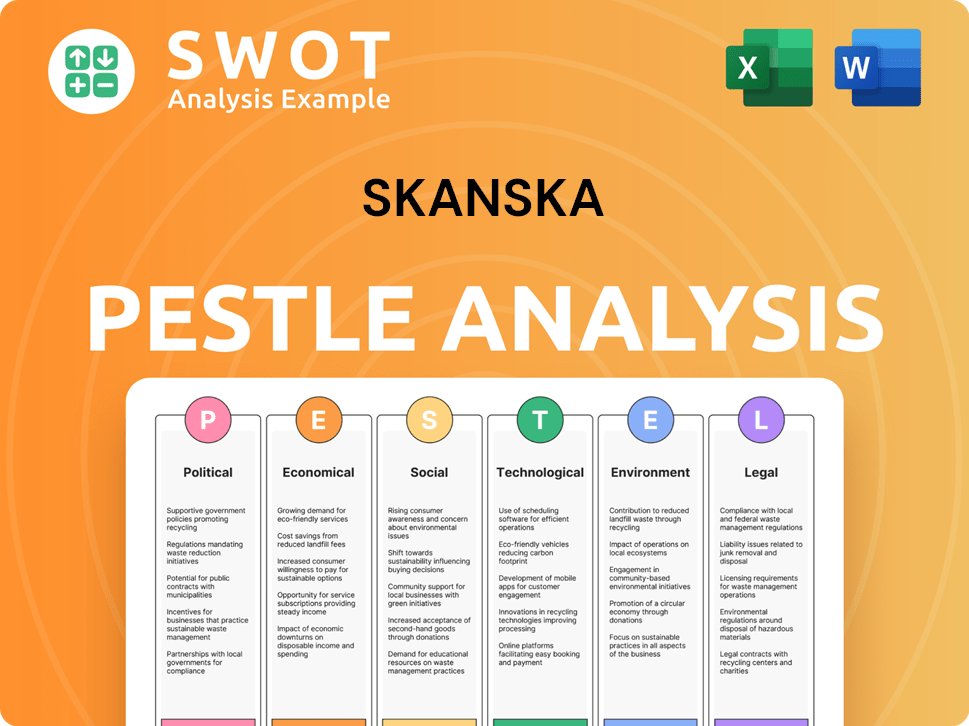
What Is Skanska’s Growth Forecast?
The financial outlook for Skanska is centered on achieving sustainable growth and maintaining a strong financial position. The company's strategy involves a focus on profitable projects and disciplined capital allocation. Skanska's approach aims to generate value for shareholders while navigating the complexities of the construction industry.
Skanska's financial performance in 2023, as reported in its Q4 results, showed resilience and strategic execution. The company's order bookings in construction reached SEK 50.8 billion, and the order backlog stood at SEK 200.7 billion, providing a solid base for future revenue. This robust backlog is crucial for supporting Skanska's mission and its long-term financial outlook.
Skanska anticipates a stable construction market in several key regions for 2024. The company's operating income for Q4 2023 was SEK 2.3 billion, with an operating margin of 3.8 percent in construction. This performance underscores Skanska's ability to manage projects efficiently and maintain healthy profit margins. Skanska's focus on project selectivity and operational efficiency is key to achieving its financial goals.
Skanska's financial performance is a key indicator of its overall health and strategic execution. The company's ability to secure substantial order bookings and maintain a robust backlog demonstrates its market position and capacity for future growth. Skanska's financial performance is influenced by its project selection and operational efficiency.
The order backlog of SEK 200.7 billion is a critical factor in Skanska's future revenue generation. This substantial backlog provides a strong foundation for the company's construction activities and revenue streams. The order backlog is a key element in Skanska's strategic planning and financial projections.
Skanska aims to maintain healthy profit margins by focusing on project selectivity and operational efficiency. The company's financial strategy involves careful project selection and efficient execution to ensure profitability. This approach is essential for achieving sustainable returns and maintaining a strong financial position.
Investment levels are expected to remain consistent with Skanska's growth ambitions, particularly in its project development segments. The company's strategic investments in commercial property, residential, and infrastructure projects are crucial for long-term growth. These investments are aligned with Skanska's broader strategic objectives.
Skanska's financial strategy includes optimizing its capital structure and potentially exploring further capital raises if significant expansion opportunities arise. The company's robust cash flow generation and prudent financial management are vital for supporting its growth trajectory and mitigating potential market volatilities. The long-term financial goals include generating sustainable returns for shareholders and maintaining a strong financial position.
Skanska's revenue growth is driven by its strong order backlog and strategic investments in key projects. The company's focus on project development, including commercial property, residential, and infrastructure, contributes significantly to revenue growth. These factors are crucial for Skanska's long-term financial outlook.
Skanska employs robust risk management strategies to mitigate potential market volatilities and ensure project success. These strategies include careful project selection, efficient operational practices, and prudent financial management. Effective risk management is essential for maintaining financial stability.
Skanska is committed to sustainable construction practices, which are increasingly important in the industry. The company integrates sustainability into its projects, focusing on reducing environmental impact and promoting long-term value. These initiatives align with Skanska's broader sustainability goals.
Skanska invests in digital construction technologies to enhance efficiency and innovation. These investments include Building Information Modeling (BIM) and other digital tools to improve project management and outcomes. Digital construction is a key area of focus for Skanska.
Skanska's expansion plans involve strategic investments in key markets and project development. The company focuses on growing its presence in regions with strong construction demand. These plans are designed to support long-term growth and market position.
Skanska's competitive advantages include its strong brand reputation, extensive experience, and focus on innovation. The company's ability to secure large projects and deliver them efficiently sets it apart. These advantages are crucial in the construction market.
Skanska Business Model Canvas
- Complete 9-Block Business Model Canvas
- Effortlessly Communicate Your Business Strategy
- Investor-Ready BMC Format
- 100% Editable and Customizable
- Clear and Structured Layout
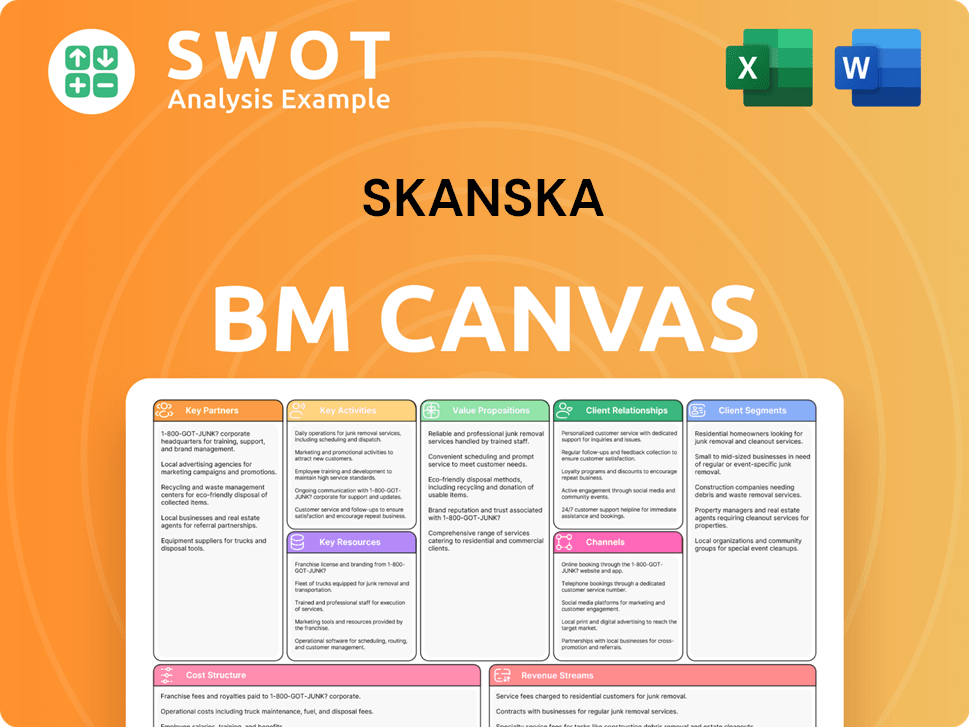
What Risks Could Slow Skanska’s Growth?
The construction and development sector presents several potential risks and obstacles to Skanska's growth strategy and future prospects. These challenges range from intense market competition and regulatory shifts to supply chain vulnerabilities and the need to adapt to technological advancements. Understanding and proactively managing these risks is crucial for maintaining Skanska's market position and achieving its financial goals.
Market competition is a significant factor, with numerous firms vying for projects, potentially leading to price pressures and reduced profit margins. Regulatory changes, especially concerning environmental standards and building codes, can also impact project costs and schedules. Moreover, supply chain disruptions and the need to adopt new technologies pose additional hurdles that Skanska must navigate to ensure its continued success.
Internal resource constraints, such as a shortage of skilled labor, could hinder project execution and growth. Skanska addresses these risks through a comprehensive risk management framework. This framework includes diversifying its project portfolio across geographies and sectors, robust contract management, and scenario planning to anticipate and prepare for potential disruptions. The company also emphasizes continuous employee training and development to mitigate skill gaps. For further insights, you can explore Owners & Shareholders of Skanska.
The construction industry is highly competitive, with numerous players vying for projects. This can lead to pricing pressures, potentially impacting Skanska's financial performance. The company must continually assess market conditions and bid strategically to maintain profitability. In 2024, the construction market saw increased competition, which impacted margins across various projects.
Changes in environmental regulations, building codes, and labor laws can significantly affect project costs and timelines. Compliance with these regulations may require investments in new equipment, materials, and construction methods. For example, stricter emissions standards may necessitate adopting greener technologies, adding to project expenses. The construction industry is facing an increasing number of regulatory changes, which are driving up compliance costs.
Supply chain vulnerabilities, exacerbated by global events, can lead to material shortages and increased costs. Skanska's financial performance can be affected by delays and higher expenses if critical materials are unavailable or expensive. The firm needs to develop robust supply chain management strategies to mitigate these risks effectively. Material cost inflation has been a significant challenge in the construction sector in 2024, affecting project profitability.
Failing to adapt quickly to new innovations or if competitors gain a significant technological edge can present a risk. Investing in digital construction, Building Information Modeling (BIM), and other technologies is essential for Skanska to stay competitive. The adoption of new technologies is crucial for improving efficiency and productivity in the construction sector.
Skanska Porter's Five Forces Analysis
- Covers All 5 Competitive Forces in Detail
- Structured for Consultants, Students, and Founders
- 100% Editable in Microsoft Word & Excel
- Instant Digital Download – Use Immediately
- Compatible with Mac & PC – Fully Unlocked
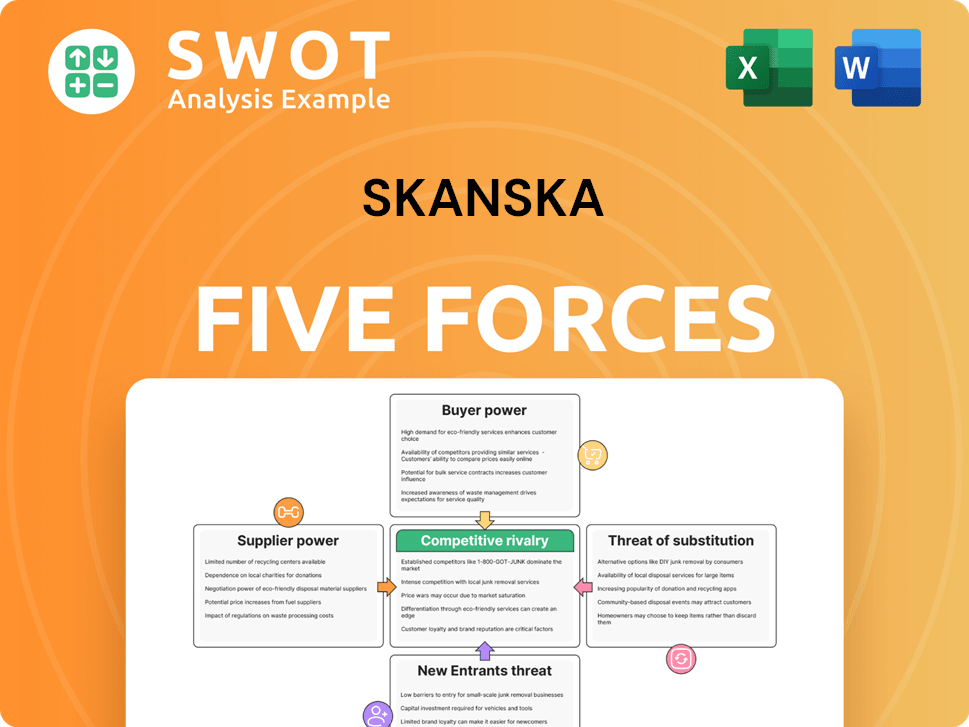
Related Blogs
- What are Mission Vision & Core Values of Skanska Company?
- What is Competitive Landscape of Skanska Company?
- How Does Skanska Company Work?
- What is Sales and Marketing Strategy of Skanska Company?
- What is Brief History of Skanska Company?
- Who Owns Skanska Company?
- What is Customer Demographics and Target Market of Skanska Company?
Disclaimer
All information, articles, and product details provided on this website are for general informational and educational purposes only. We do not claim any ownership over, nor do we intend to infringe upon, any trademarks, copyrights, logos, brand names, or other intellectual property mentioned or depicted on this site. Such intellectual property remains the property of its respective owners, and any references here are made solely for identification or informational purposes, without implying any affiliation, endorsement, or partnership.
We make no representations or warranties, express or implied, regarding the accuracy, completeness, or suitability of any content or products presented. Nothing on this website should be construed as legal, tax, investment, financial, medical, or other professional advice. In addition, no part of this site—including articles or product references—constitutes a solicitation, recommendation, endorsement, advertisement, or offer to buy or sell any securities, franchises, or other financial instruments, particularly in jurisdictions where such activity would be unlawful.
All content is of a general nature and may not address the specific circumstances of any individual or entity. It is not a substitute for professional advice or services. Any actions you take based on the information provided here are strictly at your own risk. You accept full responsibility for any decisions or outcomes arising from your use of this website and agree to release us from any liability in connection with your use of, or reliance upon, the content or products found herein.